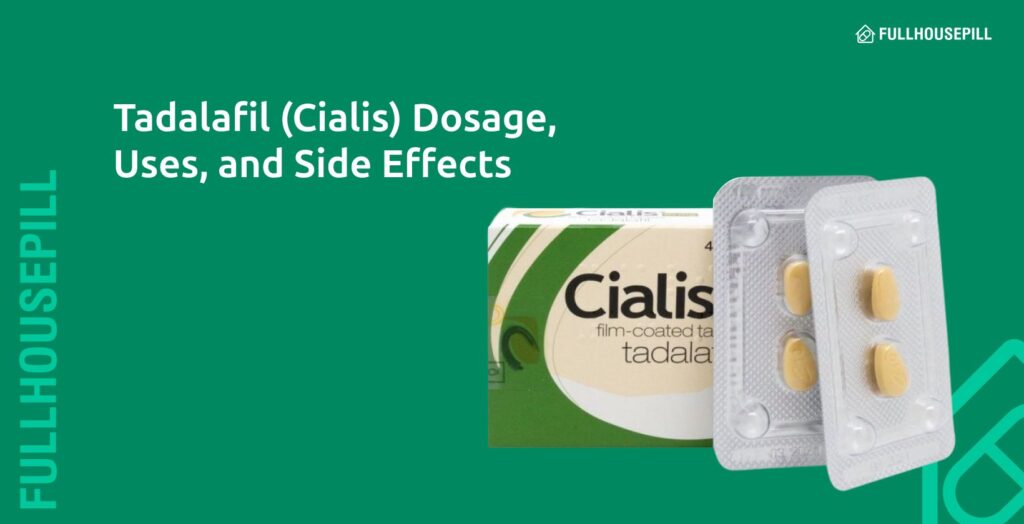Tadalafil is a PDE5 inhibitor approved for erectile dysfunction (ED), benign prostatic hyperplasia (BPH), and pulmonary arterial hypertension (PAH). It works by sustaining cGMP levels to relax smooth muscle and improve blood flow. In ED, tadalafil improves penile blood flow, with Porst et al. (2003, European Urology) confirming higher International Index of Erectile Function scores versus placebo. According to a 2008 study published in The Journal of Urology, for BPH, 5 mg once daily reduces urinary symptoms. In PAH, 40 mg once daily lowers pulmonary pressure and enhances exercise capacity, as shown by Galiè et al. (2009, Circulation). Dosing varies: 10–20 mg as needed for ED, 2.5–5 mg daily for continuous therapy, 5 mg daily for BPH, and 40 mg daily for PAH. Studies confirm efficacy across these regimens, with long-lasting effects up to 36 hours.
What is Tadalafil?
Tadalafil is a selective phosphodiesterase type 5 (PDE5) inhibitor that is marketed under the brand name Cialis and as generic versions such as Vidalista, both of which share the same mechanism of action. According to Kloner et al. (2003) in The American Journal of Cardiology, this mechanism focuses on smooth muscle relaxation and vascular regulation, which form the basis of tadalafil’s therapeutic activity.
The drug works by interfering with the breakdown of cyclic guanosine monophosphate (cGMP), a molecule central to vascular signaling. Nitric oxide first activates guanylyl cyclase, which then increases the production of cGMP. Tadalafil blocks PDE5, the enzyme that normally degrades cGMP, which allows cGMP to persist longer in tissues. This sustained presence of cGMP promotes smooth muscle relaxation, leading to enhanced blood flow. Francis et al. (2010) in Circulation Research described this sequence as the fundamental pathway through which tadalafil produces clinical benefits.
The therapeutic value of this mechanism is evident in conditions where the FDA has granted approval. In erectile dysfunction, tadalafil increases blood flow in the corpus cavernosum, resulting in improved erectile function. Porst et al. (2003) in European Urology demonstrated that men taking tadalafil achieved significantly higher International Index of Erectile Function (IIEF) scores compared with placebo. In benign prostatic hyperplasia, the same pathway reduces tone in the prostate and bladder neck, easing urinary symptoms. Roehrborn et al. (2008) in The Journal of Urology confirmed these improvements in randomized clinical trials. In pulmonary arterial hypertension, the vasodilatory effect of tadalafil lowers pulmonary artery pressure and enhances exercise capacity. Galiè et al. (2009) in Circulation provided clinical evidence of its efficacy in this setting.
Although not officially approved, tadalafil has been studied in conditions such as Peyronie’s disease, where smooth muscle relaxation may support treatment outcomes. Ralph et al. (2009) in The Journal of Sexual Medicine noted potential benefits, though data remain less robust than in approved indications.
The connection across these applications lies in the shared biological pathway. In erectile dysfunction, improved penile blood flow results from relaxation of vascular smooth muscle. In benign prostatic hyperplasia, reduced smooth muscle tone decreases urinary obstruction. In pulmonary arterial hypertension, dilation of pulmonary vessels reduces resistance and improves cardiac output. Andersson (2018) in Pharmacological Reviews emphasized that this common cGMP-mediated pathway explains how tadalafil achieves therapeutic outcomes in diverse conditions by sustaining smooth muscle relaxation across different organ systems.
What Are the Available Dosage Forms and Strengths of Tadalafil?
Tadalafil is available in multiple dosage forms that support different patient needs. Conventional oral tablets remain the standard formulation, while oral suspensions are used in patients who cannot swallow tablets. Oral dispersible films have also been developed to improve compliance. According to the Multicenter Review of a Tadalafil Suspension Formulation for Infants and Children with Pulmonary Hypertension, suspension formulations enable accurate weight-based dosing. Clinical evidence confirms four main tablet strengths: 2.5 mg, 5 mg, 10 mg, and 20 mg, while a 40 mg strength is approved for pulmonary arterial hypertension under the brand Adcirca. The Tadalafil Pharmacokinetics in Healthy Subjects study verified the bioavailability and safety of 10 mg and 20 mg strengths, supporting their clinical use.
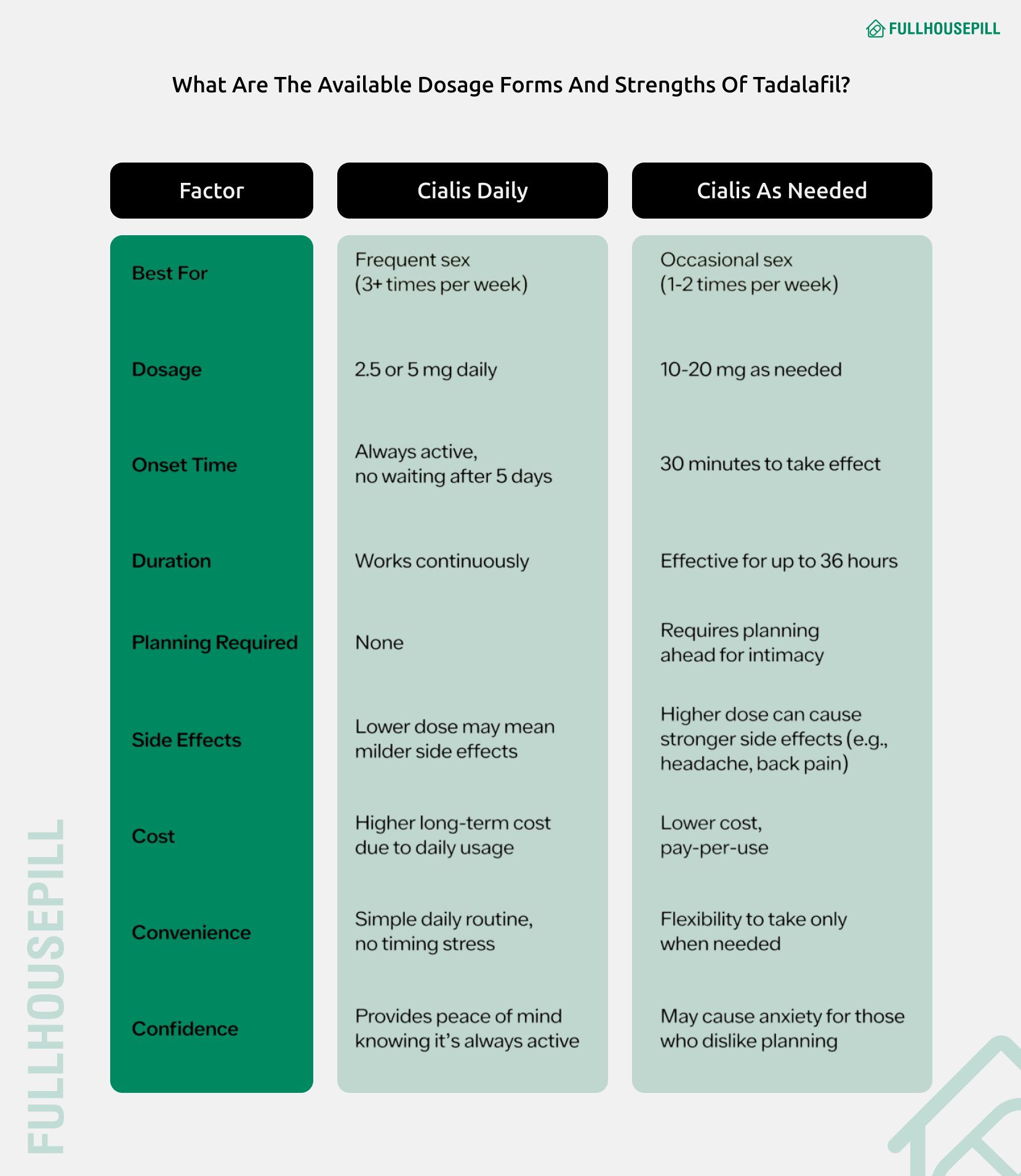
Tadalafil 2.5 mg
Tadalafil 2.5 mg once daily is the lowest approved dose for erectile dysfunction treatment. According to the Evaluation of the Long-Term Safety and Effectiveness of Tadalafil Once Daily in Chinese Men with Erectile Dysfunction study, this dose maintains safety while supporting efficacy in continuous therapy. The Update in Improving Erectile Dysfunction Therapy in Indonesia by Using Li-ESWT and Tadalafil Combination study showed that 2.5 mg monotherapy improved both Erection Hardness Score (EHS) and International Index of Erectile Function-5 (IIEF-5) scores. This dose is often chosen for men sensitive to higher doses or those experiencing dose-related side effects. The Health-Care Resource Utilization and Treatment Patterns in Men with Erectile Dysfunction and Benign Prostatic Hyperplasia-Associated Lower Urinary Tract Symptoms study further confirmed that adherence rates were higher with 2.5 mg daily dosing compared to as-needed use.
Tadalafil 5mg
Tadalafil 5 mg once daily is widely prescribed for benign prostatic hyperplasia and combined erectile dysfunction with urinary symptoms. According to the Treatment of Benign Prostatic Hyperplasia and Erectile Dysfunction with Tadalafil in the General Practice study, 5 mg showed significant efficacy in reducing lower urinary tract symptoms. The Comparison of the Clinical Efficacy of Daily Use of L-Arginine, Tadalafil and Combined L-Arginine with Tadalafil study reported improved Sexual Health Inventory for Men (SHIM) scores and higher testosterone levels in older men using this dose. The Icarifil® in Association with Daily Use of Tadalafil study showed superior IIEF-5 score improvements with 5 mg compared to 2.5 mg, confirming its status as the standard dose for dual-indication management.
Tadalafil 10mg
Tadalafil 10 mg is considered the standard starting as-needed dose for erectile dysfunction. The Tadalafil in the Treatment of Erectile Dysfunction: An Overview of the Clinical Evidence study identified 10 mg as effective in initiating therapy. The Use of Tadalafil for Treating Pulmonary Arterial Hypertension Secondary to Chronic Obstructive Pulmonary Disease study evaluated 10 mg every other day as an introductory regimen, showing good tolerability. In comparison, the Efficacy and Safety of Tadalafil Taken as Needed for the Treatment of Erectile Dysfunction in Asian Men study reported a success rate of 64.1% at 10 mg, slightly lower than the 70.5% observed with 20 mg, but still clinically meaningful for patients preferring lower initial doses.
Tadalafil 20 mg
Tadalafil 20 mg represents the maximum as-needed dose for erectile dysfunction. The Open-Label, Intermittent Dose, Prospective Study Evaluating the Effects of Tadalafil on Lower Urinary Tract Symptoms and Erectile Function study showed that 20 mg taken every three days improved both erectile function and urinary outcomes. The Efficacy and Safety of Tadalafil Taken as Needed for the Treatment of Erectile Dysfunction in Asian Men study confirmed that 20 mg achieved a 70.5% success rate, making it the most effective as-needed option. For pulmonary arterial hypertension in pediatric patients under 40 kg, the Efficacy and Safety of Tadalafil in a Pediatric Population with Pulmonary Arterial Hypertension study reported that 20 mg once daily was effective and well tolerated.
Tadalafil 40 mg
Tadalafil 40 mg is the highest approved therapeutic dose and is indicated for pulmonary arterial hypertension. The Population Pharmacokinetics of Tadalafil in Pediatric Patients with Pulmonary Arterial Hypertension study confirmed that 40 mg once daily is appropriate in adults and in pediatric patients over 40 kg. The Macitentan Tadalafil Fixed Dose Combination study showed that 40 mg in combination therapy reduced pulmonary vascular resistance more effectively than monotherapy. The Clinical Utility of Tadalafil in the Treatment of Pulmonary Arterial Hypertension study confirmed 40 mg once daily as the established dose, providing long-term benefits through its extended 17.5-hour half-life.
Tadalafil 60 mg
Tadalafil 60 mg is not an approved dose in clinical practice. The Effects of Dose and Age on Adverse Events Associated with Tadalafil study evaluated doses up to 40 mg, but did not support escalation to 60 mg. The Dual Phosphodiesterase Type 5 Inhibitor Therapy for Refractory Pulmonary Arterial Hypertension study also confirmed that combination regimens do not exceed 40 mg of tadalafil. No clinical evidence supports the safety or efficacy of 60 mg, and this dose is not recommended by regulatory authorities.
The overall comparison shows that lower doses such as 2.5 mg and 5 mg are used for daily therapy with high adherence and tolerability. Mid-range doses like 10 mg and 20 mg provide strong as-needed efficacy for erectile dysfunction. The 40 mg dose is reserved for pulmonary arterial hypertension where sustained vasodilation is required. In contrast, 60 mg remains unsupported and outside approved therapeutic guidelines.
What Is the Recommended Dosage of Tadalafil?
Recommended tadalafil dosing depends on the condition: for ED use 10–20 mg PRN or 2.5–5 mg once daily; for BPH use 5 mg once daily; for PAH use 40 mg once daily in adults and weight-based 20/40 mg in children; for Peyronie’s disease clinicians commonly use 5 mg once daily off-label.
Erectile Dysfunction (ED)
For as-needed use, tadalafil is usually taken at 10 mg or 20 mg about 30 minutes before sexual activity. The A Comparative Evaluation of Phosphodiesterase-5 Inhibitors in Erectile Dysfunction Treatment study identified these as standard doses. The Evaluation of efficacy and safety profile of tadalafil 5 mg daily dose study showed that 10 mg can be used as a starting point, with an increase to 20 mg if needed.
For daily use, the recommended dose is 5 mg once a day, regardless of when sexual activity occurs. The Role of application of tadalafil 5 mg once-daily study confirmed this regimen. The Effect of tadalafil 5 mg daily treatment study also reported significant improvement in IIEF-5 scores (p<0.01). For men who need a lower option, the An update in improving erectile dysfunction therapy in Indonesia study supported 2.5 mg daily as an alternative.
Benign Prostatic Hyperplasia (BPH)
For BPH, the standard dose is 5 mg once daily. The Efficacy and Safety of 12-week Monotherapy With Once Daily 5 mg Tadalafil for Lower Urinary Tract Symptoms of Benign Prostatic Hyperplasia study validated this approach. The Tadalafil 5 mg Alone or in Combination with Tamsulosin study further confirmed that 5 mg daily improves International Prostate Symptom Scores (IPSS). The Use of a single daily dose of tadalafil to treat signs and symptoms of benign prostatic hyperplasia and erectile dysfunction study also showed benefit in men with both BPH and ED.
Pulmonary Arterial Hypertension (PAH)
For adults, the approved dose is 40 mg once daily, marketed as Adcirca. The Population Pharmacokinetics of Tadalafil in Pediatric Patients with Pulmonary Arterial Hypertension study and the Clinical utility of tadalafil in the treatment of pulmonary arterial hypertension study both confirmed this regimen improves exercise capacity and hemodynamic outcomes.
For children, dosing depends on weight: 20 mg once daily for those under 40 kg and 40 mg once daily for those over 40 kg. The Efficacy and safety of tadalafil in a pediatric population with pulmonary arterial hypertension study and the Pharmacokinetics and safety of tadalafil in a paediatric population study confirmed this approach provides appropriate drug levels.
Peyronie’s disease
Tadalafil is not officially approved but is sometimes used off-label. The Treatment of acute phase of Peyronie’s disease with tamoxifen and vardenafil/tadalafil off-label study used 5 mg once daily in combination therapy. The Tadalafil once daily and intralesional verapamil injection study also applied 5 mg daily with injections. The Phosphodiesterase type 5 inhibitors do not prevent curvature progression study showed that 5 mg daily reduced pain duration during the active phase, though it did not prevent curve progression.
Adjustments may be required depending on response and tolerability. The A once-daily dose of tadalafil for erectile dysfunction study highlighted this need. The Short- and long-term follow-up results of daily 5-mg tadalafil study confirmed that 5 mg once daily offers sustained benefits in ED and related conditions during prolonged use.
How Should You Take and Use Tadalafil?
Tadalafil should be taken exactly as prescribed, with or without food, since its absorption is not affected by meals. According to the Phosphodiesterase type 5 inhibitor differentiation study, tadalafil absorption remains consistent whether it is taken with food or on an empty stomach. This finding was reinforced by the Bioequivalence and food effect of macitentan/tadalafil 10/20 mg fixed‐dose combination study, which confirmed no significant difference in tadalafil exposure under fed versus fasted conditions, supporting its flexible administration.
Tadalafil begins to act quickly, with onset occurring as early as 30 minutes after dosing in many patients. The Tadalafil pharmacokinetics in healthy subjects study reported that the drug reaches its mean maximum plasma concentration at about 2 hours post-dose. Clinical trials on erectile dysfunction further showed that efficacy can be noticed within 30 minutes, with improved erectile function observed in most patients within one hour of taking a 10–20 mg dose.
The effects of tadalafil last significantly longer than many other PDE5 inhibitors, allowing more flexibility in use. The Phosphodiesterase type 5 inhibitor differentiation study highlighted that tadalafil’s prolonged half-life provides responsiveness for up to 36 hours after dosing. This is supported by the Tadalafil pharmacokinetics in healthy subjects study, which reported a mean terminal half-life of 17.5 hours, with a range between 11.5 to 29.6 hours, making it a long-acting option for erectile dysfunction management.
Patients should take tadalafil in line with their treatment plan, either on an as-needed or once-daily basis. For as-needed dosing, typically 10–20 mg, the medication should be taken 30 minutes to 2 hours before sexual activity, as its effects may last up to 36 hours. According to clinical guidance drawn from efficacy trials, this extended duration supports greater spontaneity and flexibility in sexual planning. For daily dosing, usually 2.5–5 mg, tadalafil should be taken at the same time each day regardless of anticipated sexual activity, as shown in studies evaluating consistent plasma levels. Since food has no impact on drug absorption, there is no need for dose adjustment based on meals.
Can I take tadalafil daily?
Yes, you can take tadalafil daily at low doses of 2.5 mg to 5 mg, and this regimen is both approved and well-studied. According to the Meta-Analysis of the Long-Term Efficacy and Tolerance of Tadalafil Daily Compared With Tadalafil On-Demand study, daily tadalafil provided superior long-term improvements in erectile function and greater treatment persistence when compared to on-demand dosing. This supports its use as a sustained therapy option rather than only an occasional treatment.
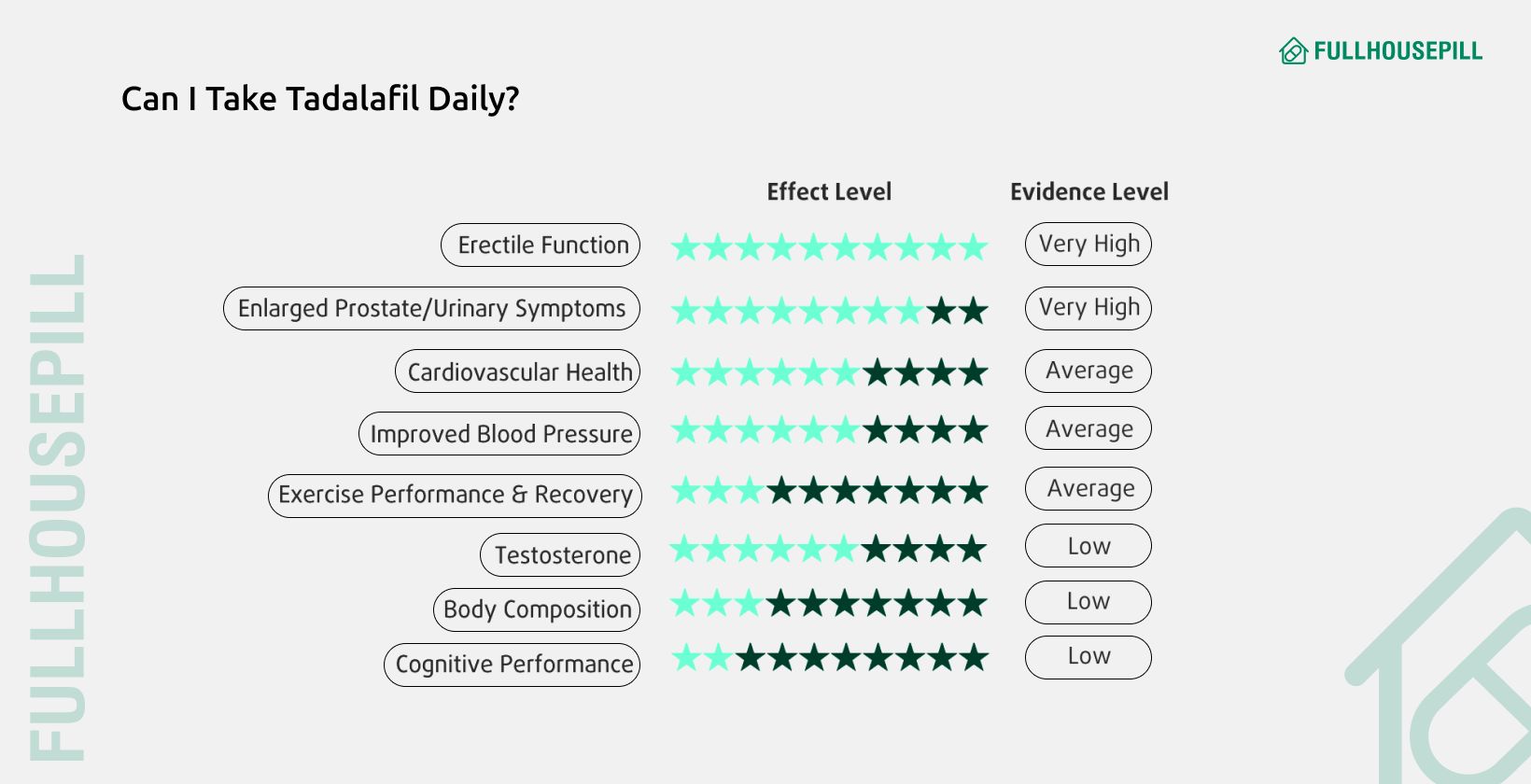
Daily use of tadalafil has also shown strong safety and effectiveness in long-term studies. The Evaluation of the long-term safety and effectiveness of tadalafil once daily in Chinese men with erectile dysfunction study confirmed that men taking 2.5 mg or 5 mg tadalafil daily for up to 24 months experienced consistent improvement in erectile function, with low discontinuation rates and stable IIEF-5 score gains. This evidence demonstrates that daily therapy is both well-tolerated and clinically reliable over extended periods.
Daily tadalafil also plays a key role in treating lower urinary tract symptoms caused by benign prostatic hyperplasia. The Efficacy and Safety of 12-week Monotherapy With Once Daily 5 mg Tadalafil for Lower Urinary Tract Symptoms of Benign Prostatic Hyperplasia study showed that men receiving 5 mg once daily had significant reductions in International Prostate Symptom Scores and improved urinary flow compared with placebo. These findings established 5 mg once daily as the standard dose for BPH management.
Sustained efficacy with minimal adverse effects has been confirmed in further clinical research. The Role of application of tadalafil 5 mg once-daily study found that men taking this dose for six months maintained improved erectile function and ejaculatory control, with statistically significant benefits (p<0.01) and low rates of side effects. These results reinforce the consistency of outcomes when tadalafil is used daily.
What is the Maximum Safe Dose of Tadalafil?
The maximum approved single dose of tadalafil for erectile dysfunction is 20 mg, taken as needed. Doses above 20 mg have not demonstrated additional efficacy and are not recommended due to increased risk of adverse effects (e.g., headache, dyspepsia).
For once-daily therapy (ED or BPH), the maximum recommended daily dose is 5 mg. Higher daily doses have not been shown to improve outcomes and carry a greater risk of dose-related side effects.
In pulmonary arterial hypertension, the maximum approved dose is 40 mg once daily (Adcirca); this dosing was validated for safety and efficacy in long-term studies, with no added benefit observed at higher doses and no data supporting doses above 40 mg.
No clinical or regulatory data support the use of tadalafil above these limits. Doses exceeding 20 mg single (ED) or 40 mg daily (PAH) exceed the standard safe upper limits established by prescribing information and have not been studied.
How often can Cialis be taken?
Cialis (tadalafil) should be taken no more than once every 24 hours. According to the Tadalafil in the treatment of erectile dysfunction; an overview of the clinical evidence study, as-needed dosing of 10–20 mg is administered at least 24 hours apart, with no more than one dose within a 24-hour period.
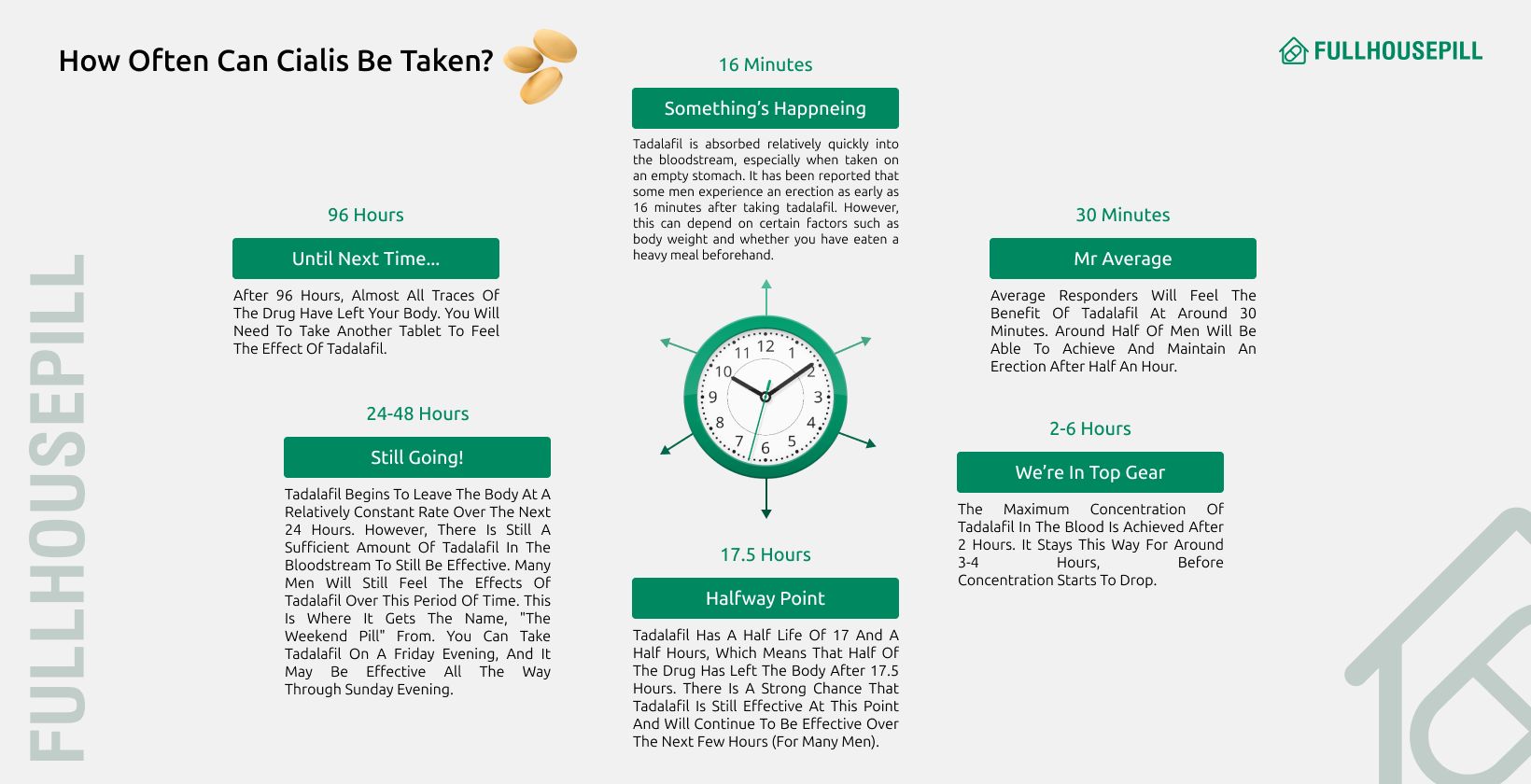
For once-daily therapy (2.5–5 mg), the A once-daily dose of tadalafil for erectile dysfunction study specifies one tablet taken once every 24 hours, regardless of timing of sexual activity, to maintain steady-state plasma levels. In clinical practice, adherence to a once-daily or once-per-day as-needed regimen ensures optimal efficacy while minimizing overlap of doses and potential adverse effects.
What happens if I take too much tadalafil?
Overdosing on tadalafil increases the risk and severity of dose-dependent adverse events such as headache, dyspepsia, back pain, myalgia, flushing, nasal congestion, and hypotension. According to the Tadalafil in the treatment of erectile dysfunction; an overview of the clinical evidence study, single doses above 20 mg (ED) or daily doses above 5 mg (once-daily regimen) have not demonstrated additional efficacy but lead to higher rates of adverse effects, with headache incidence rising from 16% at 20 mg to 28% at 40 mg. Severe hypotension or syncope may occur, especially in patients on nitrates or α-blockers (see Drug Interactions).
How long does tadalafil last in the body?
Tadalafil has an extended half-life of 17.5 hours (range 11.5–29.6 hours), supporting a duration of action up to 36 hours post-dose. However, it takes about 3 to 4 days to clear Cialis from your system after the last dose. Tadalafil levels in the body rise in proportion to the dose taken, usually between 2.5 mg and 20 mg. When used once daily, steady levels build up within 5 days, and overall exposure is about 1.6 times higher than after a single dose. The liver processes most of the drug through an enzyme called CYP3A4. Medicines that block this enzyme, such as ritonavir or ketoconazole, can increase tadalafil levels in the body. After a single 20 mg dose, measurable concentrations are seen in the blood, which explains its long-lasting effect.
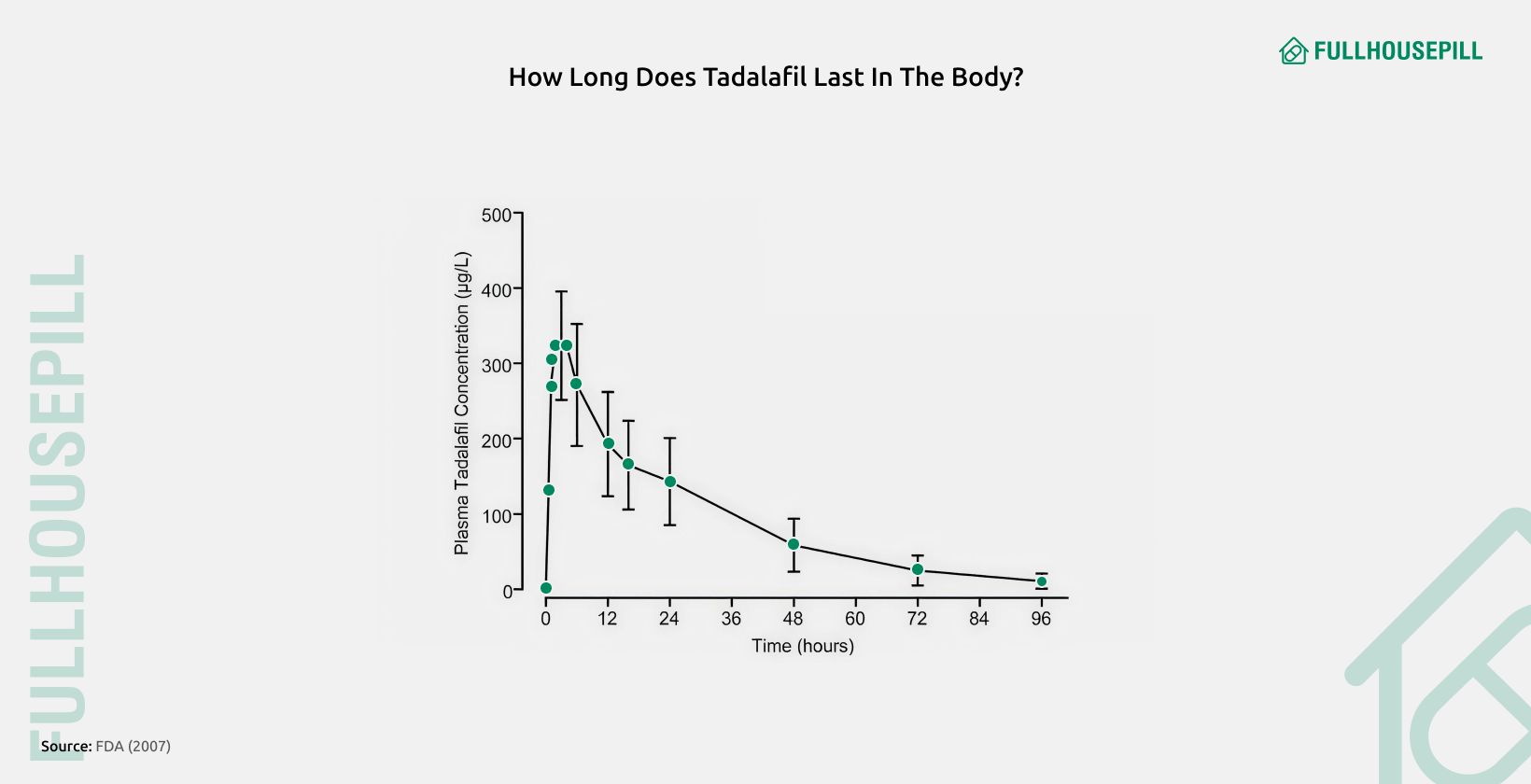
What is the best starting dose of tadalafil for ED?
For as-needed therapy, the best starting dose is 10 mg taken at least 30 minutes before sexual activity, with adjustment to 20 mg or 5 mg based on efficacy and tolerability. According to the Evaluation of efficacy and safety profile of tadalafil 5 mg daily dose study, many patients achieve optimal response with 10 mg, minimising adverse effects compared to 20 mg.
Can Tadalafil Be Taken With Alcohol?
Yes, tadalafil can generally be taken with moderate amounts of alcohol, but caution is necessary. According to the Phosphodiesterase type 5 inhibitor differentiation based on selectivity, pharmacokinetic, and efficacy profiles study, clinical trials showed that moderate alcohol intake, defined as up to two standard drinks, did not significantly change tadalafil’s pharmacokinetic profile.
The same study also reported that patients taking 10 mg or 20 mg tadalafil with moderate alcohol did not experience meaningful differences in blood pressure or alcohol-related side effects compared to placebo. This means occasional use of Cialis and alcohol together is unlikely to cause harm when consumption is limited. However, the study also warned that excessive drinking while using tadalafil can increase the likelihood of symptomatic hypotension, dizziness, headache, or fainting. These risks become more significant in people with underlying cardiovascular conditions or those already on medications that lower blood pressure, making moderation essential for safety.
What Are the Drug Interactions of Tadalafil?
Tadalafil interacts with several drug classes, and understanding these interactions is important for safe use and effective treatment. Key drug interactions of tadalafil include:
- Nitrates: Co-administration is contraindicated because the combination can cause profound hypotension, posing a serious cardiovascular risk.
- α-Blockers: Concurrent use may produce additive blood-pressure-lowering effects, leading to symptomatic hypotension. Patients should start tadalafil at the lowest dose and have their blood pressure closely monitored.
- CYP3A4 Inhibitors (e.g., ketoconazole, ritonavir): These agents increase tadalafil exposure in the body. In such cases, the dose should be reduced to 10 mg every 72 hours or to 2.5 mg daily with potent inhibitors.
- CYP3A4 Inducers (e.g., rifampin): These drugs lower tadalafil concentrations and may reduce its efficacy. Use should be avoided, or the dose should be adjusted upward with caution under medical supervision.
What Are the Side Effects of Tadalafil?
Tadalafil can cause both common and rare side effects, and awareness of these reactions helps in the safer use of the medication.
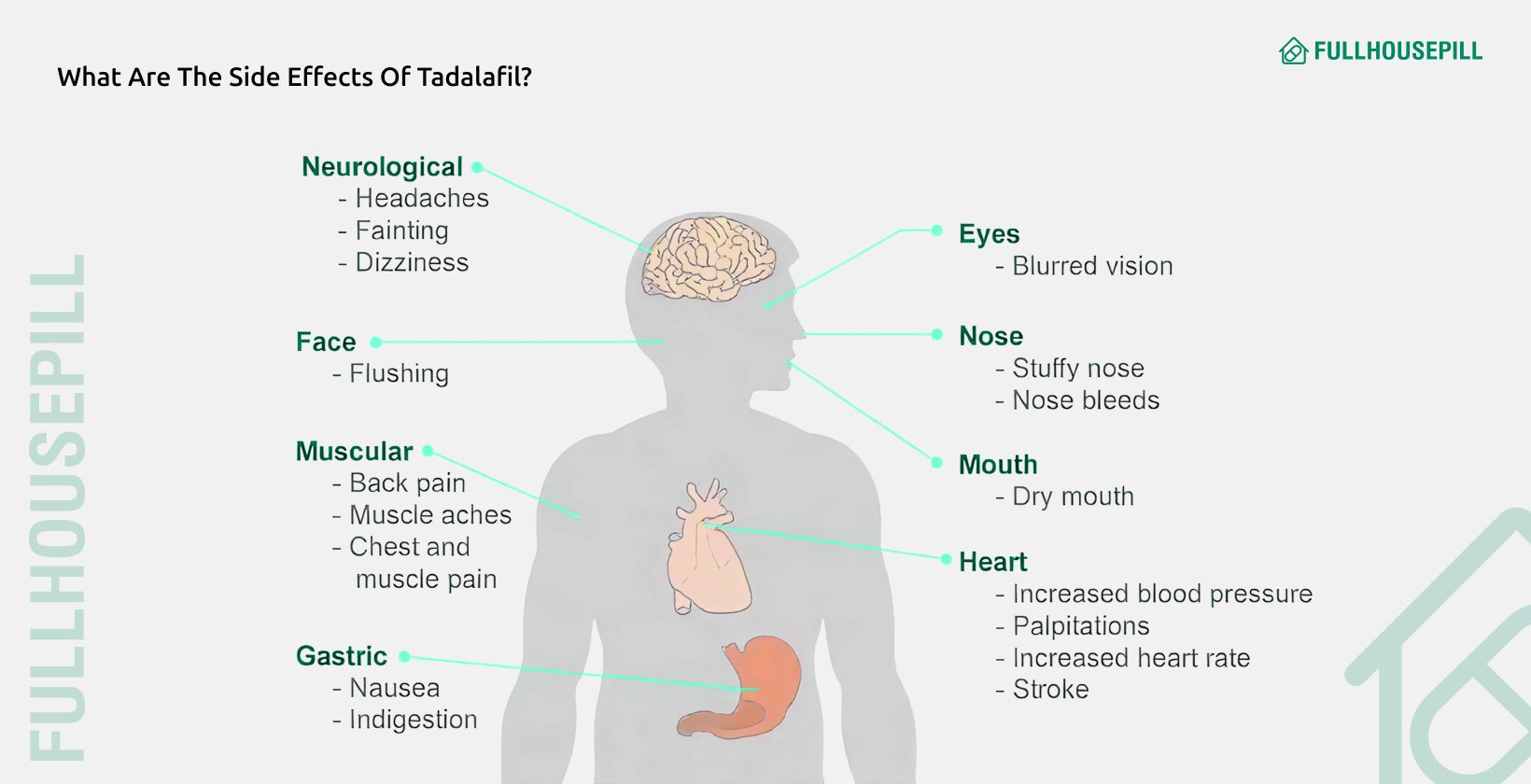
Common side effects of tadalafil include:
- Headache (16–28%): reported as the most frequent adverse effect.
- Dyspepsia (6–11%): often described as indigestion or stomach discomfort.
- Back pain (3–8%): usually mild to moderate and self-limiting.
- Myalgia (2–5%): muscle aches that may accompany back pain.
- Flushing (4–8%): a feeling of warmth or redness in the skin.
- Nasal congestion (5–10%): often related to its vasodilatory effect.
- Mild hypotension: slight lowering of blood pressure in some patients.
Serious but rare side effects of tadalafil include:
- Priapism: prolonged and painful erection requiring urgent medical care.
- Vision loss (NAION): non-arteritic anterior ischemic optic neuropathy, a rare ocular event.
- Hearing impairment: sudden decrease or loss of hearing reported in isolated cases.
Why Does Tadalafil Cause Headache as a Side Effect?
Tadalafil may cause headache as a side effect because it increases cGMP levels, which leads to vasodilation in the cerebral blood vessels. The Phosphodiesterase type 5 inhibitor differentiation study reported that PDE5 inhibition extends beyond the target tissue, enhancing nitric-oxide–mediated vasorelaxation throughout the body. This systemic effect can widen cerebral vessels temporarily, which explains why some patients experience a Cialis headache as part of their treatment response.
What Is the Recommended Tadalafil Dosage for Women?
Tadalafil is not an approved medication for women. Clinical studies investigating its role in female sexual dysfunction have not demonstrated proven efficacy or established safety. As a result, there are no official dosing recommendations for women. Any consideration of Cialis for women as an off-label option should only occur under the guidance and supervision of a qualified healthcare provider.
